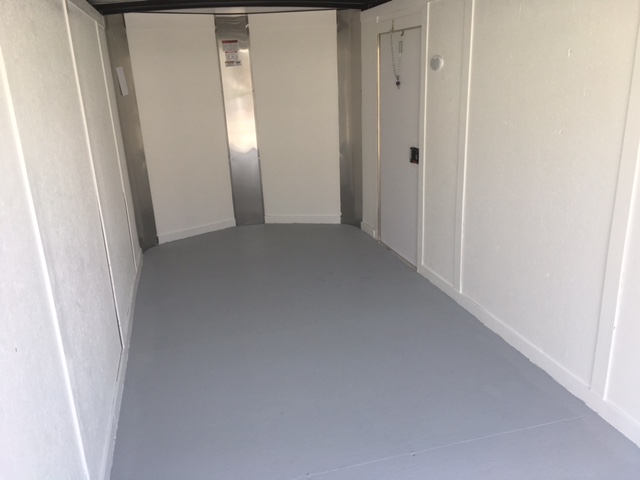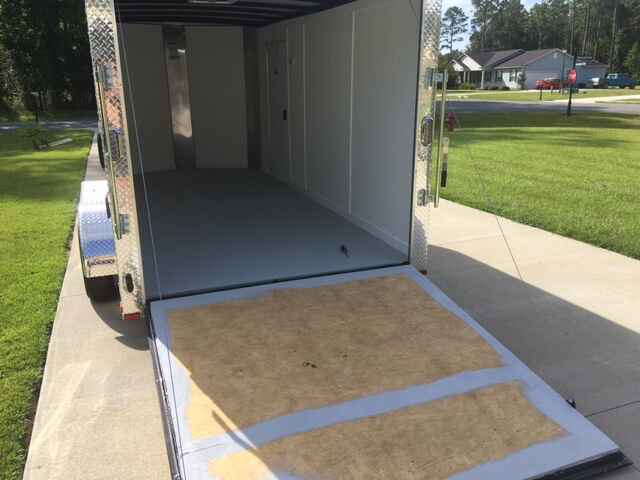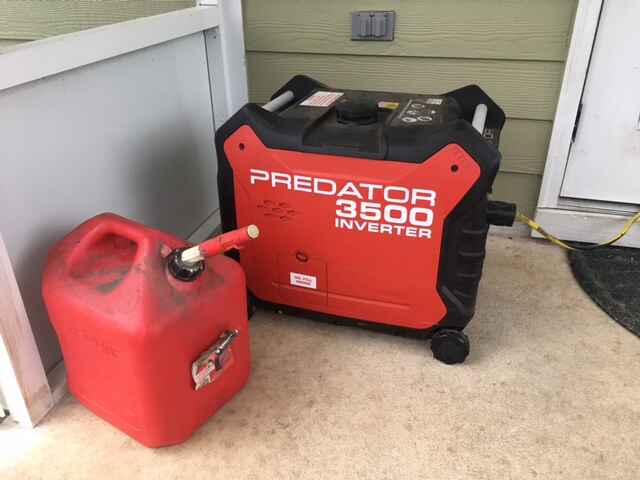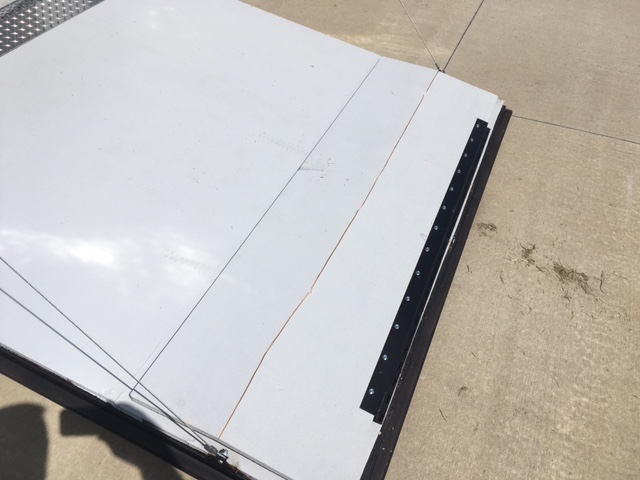I got some reflective insulating sheets from Lowes, and some long sheets of thin wood, about maybe 1/8th of an in thick. I cut the wood into long strips to run the length of the trailer, I then fed the insulation through the upper frame rails holding the roof and then slid in the thin pre cut wood strips to support the insulation where it was sagging, since there were not frame rails everywhere the insulation would sag down. I made sure it was all cut and even and then sealed the wood to the frame with some adhesive caulk. I wasn’t able to do the sides but it makes a big difference, it’s not going to be cold but it’s comfortable enough to not have to walk out every 5 minutes to get fresh air.
I’m in the process of two things. First I applied spray on bed liner to all the frame rails and underside of the floor. Figured do it now while everything is clean and rust free. I do live in Florida after all (Its wet and humid here). Second, I’m painting the interior walls with a semi gloss white, and the floor will be a textured non slip paint in grey.
Insulation is definately on my list of things to do, as is ventilation, and then A/C. Currently the roof is covered in what I can only describe a plastic coorigated card board acting like insulation.
Considering the interior is lined in OSB, you should be able to remove the sheets easily (likely attached with screws) and use a spray foam (best R value) or even a fiberglass mat between the studs. As for the roof, @SahibT 's idea sounds like a winner.
While everything is down to the bones, it would be a good time to run any electrical wiring or compressed air lines you want to add for outlets and compressor connections. Those things always come in handy. If it does not have one, you could look into a shore power panel/hook up to run from a generator or RV outlet. This will be a must have to power air-con later.
Insulation Spray foam is a great idea for the sides didn’t think of that. I know it’s pretty good at blocking the heat. Maybe it would be good on the roof too? But only thing is I don’t know if it would stick to the sheet metal on the roof but I know some people who have it in their home and get good results
One of the things I’m questioning (as I have no clue) is what materials to use on a trailer that is subject to such temp extremes and flex:
Insulation materials?
Caulking?
Anything building material I’m not considering because I have no clue what I’m doing . . .
insulation is generally able to withstand a lot of heat and won’t degrade that quickly. regular insulation in your home wether blown or batts I wouldn’t use, blown obviously because its a bunch of tiny cellulose pieces but batts are fiberglass and even these days it is thick and not good to breathe in. I would go with a thinner insulation like reflective insulation sheets (or something comprable) or insulation spray foam if possible, expansion isn’t a huge issue its more longevity and heat resistance. most modern caulks can withstand high amounts of temperature, up to about 400 degree, you can use a high temperature adhesive caulk like this, https://www.homedepot.com/p/RectorSeal-Hi-Temp-Red-Silicone-Caulk-57500/202809239. and you wouldn’t have any problems.
Trailers are traditionally insulated using foam board insulation that’s cut to fit in the openings of the trailer walls and roof. The R value of foam board insulation isn’t great, but it does make a big difference when everything is done.
I believe I put pictures in the trailer build thread of mine but you take off the walls, cut the foam board and put in place, put walls back and that’s it. It’s simple, but time consuming.
I’ve seen where people who are converting trailers to living spaces use spray insulation for better R value but it also seemed like much more work and time for someone like me that didn’t have the resources. I would not use fiberglass matting as it’ll get exposed to a lot of moisture in the trailer and I don’t think I’ve seen it in sizes that would work for the trailer wall openings without having to cut up the matting and it makes me itch just thinking about it.
You’re looking for RV rated caulk and sealer. Stays flexible, UV safe, takes high heat well.
WOW! How cool would THAT be!?
The blue or pink foam board from Lowes/Home Depot typically have an Rvalue of 5 per inch, whereas spray foam in 7 per inch. But much cheaper and easier to work with.
Almost got the interior painted, but I ran out of the Behr textured deck over paint I used for the floor.


Next order of business is putting in the e track (e track bunk beds), insulation, and then onto A/C. Not sure what route I’m going. Roof mount, mini split, portable unit, or window a/c? What ever it is, it needs to be powered by my trusty Predator 3000 watt generator. Love that generator for what it is, and for the price, cannot be beat IMHO.

Bought the piano hinge, got a 1/2 inch plywood extension, and literally the first time I roll the karts into the trailer, this happens and it snaps in half. Should I go with an alumium extension instead?

If you bought a full 1/2” sheet. I would laminate 2 pieces together to build something thicker than just miter the edge to create a small incline at the edge. You could try 3/4” plywood and might hold the weight. But you are pushing 2 karts across at once. Unless you go with a heavier gauge steel it will also bend but just won’t break.
Its tough to see how the ramp broke (it looks like the side to side?) , but if you have 2 karts on a rolling rack that is a lot of weight. You may want to look into a diamond plate tamp with built in supports. If you stick with wood I think it needs to be shorter, maybe about a foot. You could also make wedge shaped supports too if it needs to be longer.
I’m with Robert on this one. That extension is way too long for wood or even metal sheet. Just take a rip saw to it and shave it down on a bevel to just below where it split and it should be fine.
The factory installed ramp extension on my trailer is 3/4", and 12" wide for reference. Keeping in mind I’m not rolling a double stack over mine.
Yeah I think mine was 1/2 inch and 24 inches. Now its 12 inches, lol.
2 karts = ~500#! Frankly, Not sure how you rolled it up the ramp, but guessing a walking/running start. That break was predictable. I have 2 transition flaps like the 1 you have at the top of the ramp, the other being bolted to the base of the ramp for a smooth path all the way, & it works. Aluminum might be okay, but steel would fare better.
I’m with Greg and the others. The extension was too long. I run a wood extension around 12” and roll 2 karts up it on a stacker all the time.
FYI, I bought a foam ramp for wheelchairs and it has held up fine with a double stacker. Just another option to consider.
